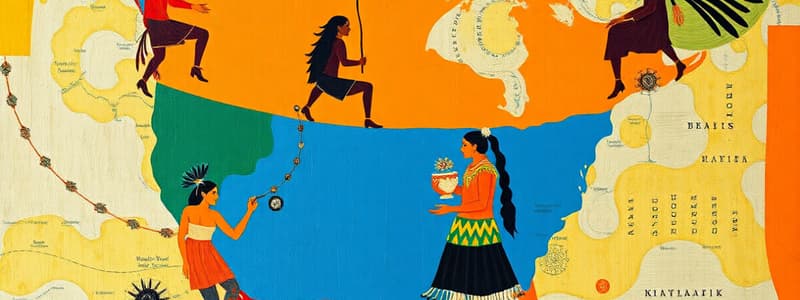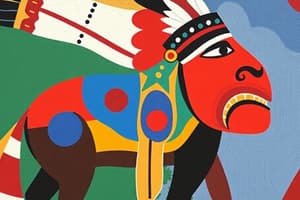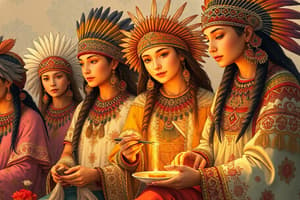Podcast
Questions and Answers
What is one theory about how the first peoples arrived in North America?
What is one theory about how the first peoples arrived in North America?
- They came by sea from Europe.
- They migrated by crossing a land bridge from Asia. (correct)
- They were native to North America.
- They arrived in groups from Africa.
Which group is known for constructing fortified cities between 700 and 1400 A.D.?
Which group is known for constructing fortified cities between 700 and 1400 A.D.?
- Maya civilization
- Hopewell culture
- Inuit descendants
- Mississippian culture (correct)
By what year did corn cultivation spread to Ontario?
By what year did corn cultivation spread to Ontario?
- 1500 A.D.
- 1000 A.D.
- 500 A.D. (correct)
- 2000 B.C.
What was a major impact of agriculture failure on the Mississippian culture?
What was a major impact of agriculture failure on the Mississippian culture?
Which Indigenous group relied heavily on farming as their means of subsistence?
Which Indigenous group relied heavily on farming as their means of subsistence?
What type of crafts are associated with the Hopewell culture?
What type of crafts are associated with the Hopewell culture?
Which of the following language groups includes Algonquian and Iroquoian?
Which of the following language groups includes Algonquian and Iroquoian?
What method did the first peoples use for hunting before bows and arrows?
What method did the first peoples use for hunting before bows and arrows?
Which Indigenous group was associated with a confederacy that consisted of four nations?
Which Indigenous group was associated with a confederacy that consisted of four nations?
What was a common lifestyle classification method for early Indigenous peoples?
What was a common lifestyle classification method for early Indigenous peoples?
What was the primary economic practice of the Five Nations Confederacy?
What was the primary economic practice of the Five Nations Confederacy?
In Iroquois society, who had the authority to select and depose chiefs?
In Iroquois society, who had the authority to select and depose chiefs?
What was the main social unit of the Plains buffalo hunters?
What was the main social unit of the Plains buffalo hunters?
Which gender was primarily responsible for farming in Iroquian-speaking societies?
Which gender was primarily responsible for farming in Iroquian-speaking societies?
What was a major motive for war in Iroquian-speaking societies?
What was a major motive for war in Iroquian-speaking societies?
How was leadership typically exercised among Woodland/subarctic groups?
How was leadership typically exercised among Woodland/subarctic groups?
What role did Siksika women have in their society after the arrival of horses?
What role did Siksika women have in their society after the arrival of horses?
Which of these statements about the leadership structure of Woodland/subarctic societies is accurate?
Which of these statements about the leadership structure of Woodland/subarctic societies is accurate?
What was the significance of the Sun Dance among Plains peoples?
What was the significance of the Sun Dance among Plains peoples?
What was the primary basis for property inheritance among the Haida?
What was the primary basis for property inheritance among the Haida?
In Huron and Iroquois trade practices, what did they primarily receive in exchange for their agricultural products?
In Huron and Iroquois trade practices, what did they primarily receive in exchange for their agricultural products?
How did the Salish women's autonomy compare to that of the Haida women?
How did the Salish women's autonomy compare to that of the Haida women?
What materials were primarily used by West Coast peoples to build their boats and houses?
What materials were primarily used by West Coast peoples to build their boats and houses?
What was the purpose of the potlatch ceremony among the West Coast peoples?
What was the purpose of the potlatch ceremony among the West Coast peoples?
What hunting methods did the Inuit use for summer whaling?
What hunting methods did the Inuit use for summer whaling?
What type of leadership structure did the Inuit have during most of the year?
What type of leadership structure did the Inuit have during most of the year?
Which animals were primarily relied upon by the coastal Indigenous peoples for their subsistence?
Which animals were primarily relied upon by the coastal Indigenous peoples for their subsistence?
What was a common belief system among the Indigenous peoples regarding the relationship with the environment?
What was a common belief system among the Indigenous peoples regarding the relationship with the environment?
In Haida society, what was the wife's expected role in relation to her husband's authority?
In Haida society, what was the wife's expected role in relation to her husband's authority?
How did the societal roles of women differ between the Haida and Salish cultures?
How did the societal roles of women differ between the Haida and Salish cultures?
Flashcards
Land Bridge Theory
Land Bridge Theory
The theory that Indigenous people in North America arrived from Asia over a land bridge between Siberia and North America, at least 14,000 years ago.
Ice-free Corridor Theory
Ice-free Corridor Theory
The theory that Indigenous people migrated southward through North America via an ice-free corridor.
Language Group
Language Group
A group of closely related languages that share a common ancestor.
Mound Builders
Mound Builders
Signup and view all the flashcards
Hopewell Culture
Hopewell Culture
Signup and view all the flashcards
Mississippian Culture
Mississippian Culture
Signup and view all the flashcards
Hopewell Expansion (100-500 AD)
Hopewell Expansion (100-500 AD)
Signup and view all the flashcards
Great Lakes Farmers
Great Lakes Farmers
Signup and view all the flashcards
Huron Confederacy
Huron Confederacy
Signup and view all the flashcards
Subsistence
Subsistence
Signup and view all the flashcards
Connection to the natural world
Connection to the natural world
Signup and view all the flashcards
Potlatch
Potlatch
Signup and view all the flashcards
Igloo
Igloo
Signup and view all the flashcards
Inuit
Inuit
Signup and view all the flashcards
Matrilineal lineage
Matrilineal lineage
Signup and view all the flashcards
Patrilineal lineage
Patrilineal lineage
Signup and view all the flashcards
Spirit world beliefs
Spirit world beliefs
Signup and view all the flashcards
Vision quest
Vision quest
Signup and view all the flashcards
Women's roles and status
Women's roles and status
Signup and view all the flashcards
Pre-contact subsistence cultures
Pre-contact subsistence cultures
Signup and view all the flashcards
Iroquois Confederacy
Iroquois Confederacy
Signup and view all the flashcards
Matrilineal Society in the Iroquois Confederacy
Matrilineal Society in the Iroquois Confederacy
Signup and view all the flashcards
Consensus Decision-Making in the Iroquois Confederacy
Consensus Decision-Making in the Iroquois Confederacy
Signup and view all the flashcards
Iroquois Warfare
Iroquois Warfare
Signup and view all the flashcards
Slash-and-Burn Agriculture among the Iroquois
Slash-and-Burn Agriculture among the Iroquois
Signup and view all the flashcards
Huron Trade Network
Huron Trade Network
Signup and view all the flashcards
Gender Roles in the Great Lakes Region
Gender Roles in the Great Lakes Region
Signup and view all the flashcards
Women's Power in Iroquian Societies
Women's Power in Iroquian Societies
Signup and view all the flashcards
Woodland/Subarctic Peoples
Woodland/Subarctic Peoples
Signup and view all the flashcards
Leadership in Woodland/Subarctic Societies
Leadership in Woodland/Subarctic Societies
Signup and view all the flashcards
Study Notes
Indigenous Peoples Before European Arrival
- Origins and Migration: First peoples originated in North America, likely migrating from Asia via a land bridge (Siberia to North America) and then southward through an ice-free corridor. Some theories propose other routes, such as coastal migration or by boat. Migrations occurred in waves, with the most recent wave leading to the Inuit.
Early Technologies and Agriculture
-
Early Tools: Early peoples used fluted weapons (spears, darts) and later developed bows and arrows.
-
Agricultural Advancements: By 5000 BC, indigenous peoples in Central America cultivated beans, pumpkins, squash, and avocados. Advanced civilizations like the Maya and Aztec arose.
Mound Builders & Early Cultures
-
Hopewell Culture: Flourished in the Ohio and Illinois River Valleys, impacting cultures further north, like those in Ontario (Canada).
-
Mississippian Culture: (700-1400 AD) Constructed fortified cities, heavily reliant on agriculture, and their influence spread into Central Canada.
Pre-Contact Demographics & Language Groups
- Population Estimates: Estimated at around 500,000 with at least 50 different languages, belonging to 10 language groups (e.g., Algonquian, Iroquoian, Siouan, Dene).
Indigenous Lifestyles & Subsistence
- Five Main Groups: Categorized by lifestyle/subsistence: Great Lakes farmers, Woodland/subarctic hunters/fishers/gatherers, Plains buffalo hunters, West-coast fishers, and Arctic hunters.
1. Great Lakes Farmers
-
Agriculture: Iroquoian-speaking peoples, relying heavily on agriculture (slash-and-burn).
-
Settlement Patterns: Semi-permanent villages (up to 1500 people)
-
Social Structure: Extended family matrilineal households with maternal inheritance.
-
Leadership: Two chiefs per village (civil and military). Village councils and confederacy councils for larger decision-making. Consensus-based decision-making.
-
Conflict/Warfare: Driven by revenge, plunder, land, and proving manhood. Captured men were often tortured, while women and children were absorbed into the captors' societies.
-
Trade: Extensive trade with Algonquian groups, exchanging corn and other products for animal skins and fish.
-
Gender Roles: While men held political office, women controlled household and much property (maternal inheritance), influencing decisions.
2. Woodland/Subarctic Hunters
-
Lifestyles: Algonquian and Dene/Athapaskan-speaking peoples, relocating seasonally to hunt/gather/fish. Lived in small bands in the winter, and combined bands in the summer.
-
Social Structure: Informal leadership, focusing on generosity. Decision-making via consensus and persuasion.
-
Women's Roles: Vital in all aspects of survival, including setting up camps, gathering and preparing food, crafting tools, clothing, and tending to children.
-
Shared Resources: Communal sharing of resources and hunting territories, crucial during scarcity.
3. Plains Buffalo Hunters
-
Subsistence: Depended on buffalo for all aspects of life (food, clothing, tools). Hunted in isolated groups or by driving herds (corraling, or cliff driving.)
-
Social Structure: Tribes composed of smaller bands with common political policy. Age-based societies (military societies) unified tribes.
-
Leadership: Persuasion-based leadership; although force was sometimes used.
-
Women's Roles: Critical in processing buffalo, creating pemmican. Increased importance of women after horse introduction, though possible reduced status with polygamy becoming more common due to increased warfare.
4. West Coast Fishers
-
Subsistence: Relied heavily on fish (salmon, herring), sea mammals (seals, otters, whales), and wood (boats, houses, totem poles).
-
Social Structure: Three social classes (nobles, commoners, slaves).
Northwestern peoples traced lineage matrilineally; southern peoples patrilineally. Lacked political units beyond individual villages. -
West Coast Women: In some groups property inherited matrilineally (Haida). Active traders (Haida), though many roles had restricted access to hunting and fishing, and limited political power, though instances of female leadership existed.
-
Ceremonies: Potlatch ceremonies for important matters (status, mourning). BC Interior, peoples had more in common with Plains people.
5. Arctic Hunters
-
Subsistence: Heavily reliant on sea and land mammals (seals, walrus, caribou), fished for char.
-
Settlement Patterns: Used kayaks, umiaks (large skin-covered boats) and winter igloos or frame houses. Small family groups.
-
Leadership: Informal and temporary leadership, but formal village leaders handled summer activities (e.g., whaling).
Indigenous Spirituality
- Interconnectedness: Believed in spiritual interconnectedness between humans, environment, animals, and objects.
- Placation & Rituals: Spirits had to be placated through rituals, prayers, and taboos. A supreme creator or Great Spirit was also believed in.
Studying That Suits You
Use AI to generate personalized quizzes and flashcards to suit your learning preferences.



